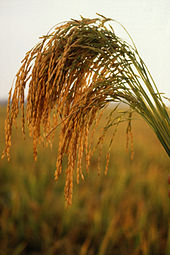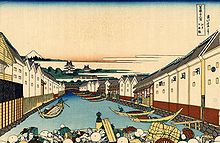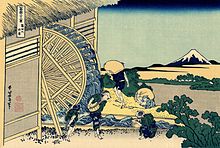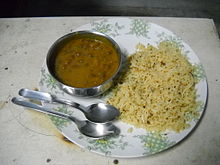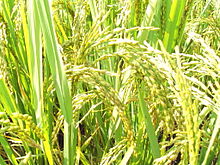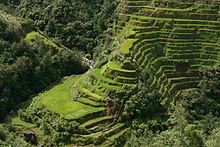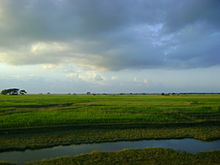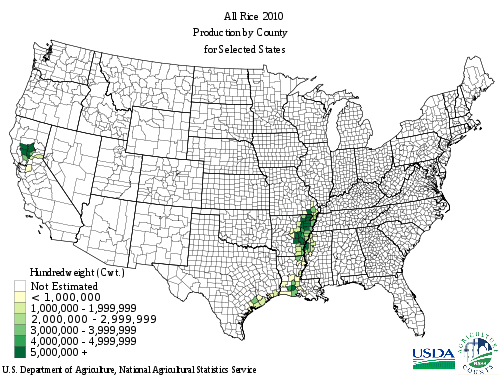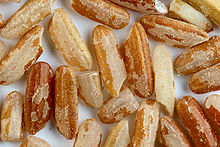- Rice
-
For other uses, see Rice (disambiguation).
 Oryza sativa, commonly known as Asian rice.
Oryza sativa, commonly known as Asian rice.
Rice, white, long-grain vegetable, raw Nutritional value per 100 g (3.5 oz) Energy 1,527 kJ (365 kcal) Carbohydrates 80 g - Sugars 0.12 g - Dietary fiber 1.3 g Fat 0.66 g Protein 7.13 g Water 11.61 g Thiamine (vit. B1) 0.0701 mg (6%) Riboflavin (vit. B2) 0.0149 mg (1%) Niacin (vit. B3) 1.62 mg (11%) Pantothenic acid (B5) 1.014 mg (20%) Vitamin B6 0.164 mg (13%) Calcium 28 mg (3%) Iron 0.80 mg (6%) Magnesium 25 mg (7%) Manganese 1.088 mg (52%) Phosphorus 115 mg (16%) Potassium 115 mg (2%) Zinc 1.09 mg (11%) Percentages are relative to US recommendations for adults.
Source: USDA Nutrient Database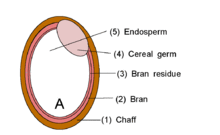 A: Rice with chaff
A: Rice with chaff
B: Brown rice
C:Rice with germ
D: White rice with bran residue
E:Musenmai (Japanese:無洗米), "Polished and ready to boil rice", literally, non-wash rice
(1):Chaff
(2):Bran
(3):Bran residue
(4):Cereal germ
(5):EndospermRice is the seed of the monocot plants Oryza sativa (Asian rice) or Oryza glaberrima (African rice). As a cereal grain, it is the most important staple food for a large part of the world's human population, especially in East Asia, Southeast Asia, South Asia, the Middle East, and the West Indies. It is the grain with the third-highest worldwide production, after maize (corn) and wheat, according to data for 2009.[1]
Rice is first mentioned in the Yajur Veda and then is frequently referred to in Sanskrit texts.[citation needed] In India, there is a saying that grains of rice should be like two brothers, close but not stuck together.[citation needed] Rice is often directly associated with prosperity and fertility, therefore there is the custom of throwing rice at weddings.[2]
Since a large portion of maize crops are grown for purposes other than human consumption, rice is the most important grain with regard to human nutrition and caloric intake, providing more than one fifth of the calories consumed worldwide by the human species.[3]
Rice is normally grown as an annual plant, although in tropical areas it can survive as a perennial and can produce a ratoon crop for up to 30 years.[4] The rice plant can grow to 1–1.8 m (3.3–5.9 ft) tall, occasionally more depending on the variety and soil fertility. It has long, slender leaves 50–100 cm (20–39 in) long and 2–2.5 cm (0.79–0.98 in) broad. The small wind-pollinated flowers are produced in a branched arching to pendulous inflorescence 30–50 cm (12–20 in) long. The edible seed is a grain (caryopsis) 5–12 mm (0.20–0.47 in) long and 2–3 mm (0.079–0.12 in) thick.
Rice cultivation is well-suited to countries and regions with low labor costs and high rainfall, as it is labor-intensive to cultivate and requires ample water. Rice can be grown practically anywhere, even on a steep hill or mountain. Although its parent species are native to South Asia and certain parts of Africa, centuries of trade and exportation have made it commonplace in many cultures worldwide.
The traditional method for cultivating rice is flooding the fields while, or after, setting the young seedlings. This simple method requires sound planning and servicing of the water damming and channeling, but reduces the growth of less robust weed and pest plants that have no submerged growth state, and deters vermin. While flooding is not mandatory for the cultivation of rice, all other methods of irrigation require higher effort in weed and pest control during growth periods and a different approach for fertilizing the soil.
(The name wild rice is usually used for species of the grass genus Zizania, both wild and domesticated, although the term may also be used for primitive or uncultivated varieties of Oryza.)
Contents
Etymology
First attested in English in the middle of the 13th century, the word rice derives from the Old French ris, which comes from Italian riso, in turn from the Latin oriza, which derives from the Greek ὄρυζα (oruza). The Greek word is the ultimate source of all European words (cf. Welsh reis, Ger. Reis, Lith. rysai, Serbo-Cr. riza, Pol. ryz, Dutch rijst, Romanian orez).[5][6][7]
Preparation as food
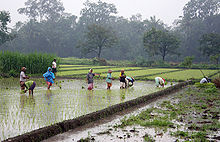 Transplanting rice seedlings in Java, Indonesia
Transplanting rice seedlings in Java, Indonesia
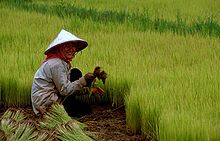 Removing seedlings from seed beds, the first step along a labour-intensive process of growing rice as seen in Cambodia
Removing seedlings from seed beds, the first step along a labour-intensive process of growing rice as seen in Cambodia
The seeds of the rice plant are first milled using a rice huller to remove the chaff (the outer husks of the grain). At this point in the process, the product is called brown rice. The milling may be continued, removing the 'bran', i.e., the rest of the husk and the germ, thereby creating white rice. White rice, which keeps longer, lacks some important nutrients; in a limited diet which does not supplement the rice, brown rice helps to prevent the disease beriberi.
White rice may also be buffed with glucose or talc powder (often called polished rice, though this term may also refer to white rice in general), parboiled, or processed into flour. White rice may also be enriched by adding nutrients, especially those lost during the milling process. While the cheapest method of enriching involves adding a powdered blend of nutrients that will easily wash off (in the United States, rice which has been so treated requires a label warning against rinsing), more sophisticated methods apply nutrients directly to the grain, coating the grain with a water insoluble substance which is resistant to washing.
In some countries parboiled rice is popular. Parboiled rice is subjected to a steaming or parboiling process while still a brown ricegrains. This causes nutrients from the outer husk, especially thiamine, to move into the grain itself. The parboil process causes a gelatinisation of the starch in the grains. The grains become less brittle, and the color of the milled grain changes from white to yellow. The rice is then dried, and can then be milled as usual or used as brown rice. Milled parboiled rice is nutritionally superior to standard milled rice. Parboiled rice has an additional benefit in that it does not stick to the pan during cooking, as happens when cooking regular white rice. This type of rice is eaten in parts of India and countries of West Africa are also accustomed to consuming parboiled rice.
Despite the hypothetical health risks of talc (such as stomach cancer),[8] talc-coated rice remains the norm in some countries due to its attractive shiny appearance, but it has been banned in some, and is no longer widely used in others (such as the United States). Even where talc is not used, glucose, starch, or other coatings may be used to improve the appearance of the grains.
Rice bran, called nuka in Japan, is a valuable commodity in Asia and is used for many daily needs. It is a moist, oily inner layer which is heated to produce oil. It is also used as a pickling bed in making rice bran pickles and Takuan.
Raw rice may be ground into flour for many uses, including making many kinds of beverages such as amazake, horchata, rice milk, and rice wine. Rice flour does not contain gluten and is suitable for people on a gluten-free diet. Rice may also be made into various types of noodles. Raw, wild, or brown rice may also be consumed by raw-foodist or fruitarians if soaked and sprouted (usually 1 week to 30 days); see also Gaba rice below.
Processed rice seeds must be boiled or steamed before eating. Boiled rice may be further fried in cooking oil or butter (known as Fried rice), or beaten in a tub to make mochi.
Rice is a good source of protein and a staple food in many parts of the world, but it is not a complete protein: it does not contain all of the essential amino acids in sufficient amounts for good health, and should be combined with other sources of protein, such as nuts, seeds, beans, fish, or meat.[9]
Rice, like other cereal grains, can be puffed (or popped). This process takes advantage of the grains' water content and typically involves heating grains in a special chamber. Further puffing is sometimes accomplished by processing pre-puffed pellets in a low-pressure chamber. The ideal gas law means that either lowering the local pressure or raising the water temperature results in an increase in volume prior to water evaporation, resulting in a puffy texture. Bulk raw rice density is about 0.9 g/cm³. It decreases to less than one-tenth that when puffed.
Cooking
- Further information: Steamed rice
There are many varieties of rice; for many purposes the main distinction is between long-, medium-, and short-grain rice. The grains of long-grain rice (high amylose) tend to remain intact after cooking; medium-grain rice (high amylopectin) becomes more sticky. Medium-grain rice is used for sweet dishes, for risotto in Italy and many rice dishes, such as arròs negre, in Spain. A stickier medium-grain rice is used for sushi; the stickiness lets the rice be moulded into a solid shape. Short-grain rice is often used for rice pudding.
 A Pakistani-style Chinese rice dish utilizing the Basmati variety
A Pakistani-style Chinese rice dish utilizing the Basmati variety Rice served along with Indian curry. Note the yellowish tinge in the rice. It is due to the common Indian practice of adding turmeric during cooking.
Rice served along with Indian curry. Note the yellowish tinge in the rice. It is due to the common Indian practice of adding turmeric during cooking.
Rice is cooked by boiling or steaming, and absorbs water during cooking. It can be cooked in just as much water as it absorbs (the absorption method), or in a large quantity of water which is drained before serving (the rapid-boil method).[10] Electric rice cookers, popular in Asia and Latin America, simplify the process of cooking rice. Rice (or any other grain) is sometimes quickly fried in oil or fat before boiling (for example saffron rice or risotto); this makes the cooked rice less sticky, and is a cooking style commonly called pilaf by American chefs or biryani (Dam-pukhtak) in India, Pakistan, and Iran.
In Arab cuisine, rice is an ingredient of many soups and dishes with fish, poultry, and other types of meat. It is also used to stuff vegetables or is wrapped in grape leaves (dolma). When combined with milk, sugar, and honey, it is used to make desserts. In some regions, such as Tabaristan, bread is made using rice flour. Medieval Islamic texts spoke of medical uses for the plant.[11]
Rice may also be made into congee (also called rice porridge), fawrclaab, okayu, Xifan, jook, or rice gruel) by adding more water than usual, so that the cooked rice is saturated with water, usually to the point that it disintegrates. Rice porridge is commonly eaten as a breakfast food, and is also a traditional food for the sick.
Rice may be soaked prior to cooking, which saves fuel, decreases cooking time, minimizes exposure to high temperature and thus decreases the stickiness of the rice. For some varieties, soaking improves the texture of the cooked rice by increasing expansion of the grains.
Instant rice differs from parboiled rice in that it is milled, fully cooked and then dried. There is a significant degradation in taste and texture.
A nutritionally superior method of preparing brown rice known as GABA Rice or GBR (Germinated Brown Rice)[12] may be used. This involves soaking washed brown rice for 20 hours in warm water (38 °C or 100 °F) prior to cooking it. This stimulates germination, which activates various enzymes in the rice. By this method, a result of research carried out for the United Nations International Year of Rice, it is possible to obtain a more complete amino acid profile, including GABA.
Cooked rice can contain Bacillus cereus spores, which produce an emetic toxin when left at 4–60 °C (39–140 °F) NZFSA.govt.nz. When storing cooked rice for use the next day, rapid cooling is advised to reduce the risk of toxin production. One of the enterotoxins produced by bacillus cereus is heat-resistant; reheating contaminated rice kills the bacteria, but does not destroy the toxin already present.
Rice flour and starch often are used in batters and breadings to increase crispiness.
Synopsis of major staple foods
The following table shows the nutrient content of major staple foods in a raw form. Raw grains, however, aren't edible and can not be digested. These must be sprouted, or prepared and cooked for human consumption. In sprouted and cooked form, the relative nutritional and anti-nutritional contents of each of these grains is remarkably different from that of raw form of these grains reported in this table.
Synopsis[13] ~ composition: Amaranth[14] Wheat[15] Rice[16] Sweetcorn[17] Potato[18] Component (per 100g portion, raw grain) Amount Amount Amount Amount Amount water (g) 11 11 12 76 82 energy (kJ) 1554 1506 1527 360 288 protein (g) 14 23 7 3 1.7 fat (g) 7 10 1 1 0.1 carbohydrates (g) 65 52 79 19 16 fiber (g) 7 13 1 3 2.4 sugars (g) 1.7 <0.1 >0.1 3 1.2 iron (mg) 7.6 6.3 0.8 0.5 0.5 manganese (mg) 3.4 13.3 1.1 0.2 0.1 calcium (mg) 159 39 28 2 9 magnesium (mg) 248 239 25 37 21 phosphorus (mg) 557 842 115 89 62 potassium (mg) 508 892 115 270 407 zinc (mg) 2.9 12.3 1.1 0.5 0.3 pantothenic acid (mg) 1.5 2.3 1.0 0.7 0.3 vitB6 (mg) 0.6 1.3 0.2 0.1 0.2 folate (µg) 82 281 8 42 18 thiamin (mg) 0.1 1.9 0.1 0.2 0.1 riboflavin (mg) 0.2 0.5 >0.1 0.1 >0.1 niacin (mg) 0.9 6.8 1.6 1.8 1.1 Rice growing ecology
Rice can be grown in different environments, depending upon water availability.[19]
- Lowland, rainfed, which is drought prone, favors medium depth; waterlogged, submergence, and flood prone
- Lowland, irrigated, grown in both the wet season and the dry season
- Deep water or floating rice
- Coastal Wetland
- Upland rice, Upland rice is also known as 'Ghaiya rice', well known for its drought tolerance[20]
History of domestication & cultivation
Asia
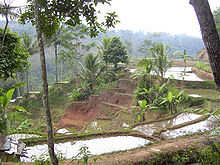 Terraced rice paddy on a hill slope in Indonesia.
Terraced rice paddy on a hill slope in Indonesia. Rice field under monsoon clouds in Pegu Division, Burma
Rice field under monsoon clouds in Pegu Division, Burma
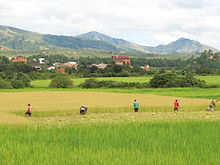 Rice crop in Madagascar
Rice crop in Madagascar
The commonly accepted view is that rice was first domesticated in the region of the Yangtze River valley in China.[21][22] Morphological studies of rice phytoliths from the Diaotonghuan archaeological site clearly show the transition from the collection of wild rice to the cultivation of domesticated rice. The large number of wild rice phytoliths at the Diaotonghuan level dating from 12,000–11,000 BP indicates that wild rice collection was part of the local means of subsistence. Changes in the morphology of Diaotonghuan phytoliths dating from 10,000–8,000 BP show that rice had by this time been domesticated.[23] Soon afterwards the two major varieties of indica and Japonica rice were being grown in Central China.[22] In the late 3rd millennium BC, there was a rapid expansion of rice cultivation into mainland Southeast Asia and westwards across India and Nepal.[22]
In 2003, Korean archaeologists claimed to have discovered the world's oldest domesticated rice.[24] Their 15,000 year old age challenges the accepted view that rice cultivation originated in China about 12,000 years ago.[24] These findings were received by academia with strong skepticism, and the results and their publicizing has been cited as being driven by a combination of nationalist and regional interests.[25] In 2011, a combined effort by the Stanford University, New York University, Washington University in St. Louis, and Purdue University has provided the strongest evidence yet that there is only one single origin of domesticated rice, in the Yangtze Valley of China.[26]
The earliest remains of rice in the Indian subcontinent have been found in the Indo-Gangetic Plain and date from 7000–6000 BC though the earliest widely accepted date for cultivated rice is placed at around 3000–2500 BC with findings in regions belonging to the Indus Valley Civilization.[27] Perennial wild rices still grow in Assam and Nepal. It seems to have appeared around 1400 BC in southern India after its domestication in the northern plains.[citation needed] It then spread to all the fertile alluvial plains watered by rivers. Cultivation and cooking methods are thought to have spread to the west rapidly and by medieval times, southern Europe saw the introduction of rice as a hearty grain.
Today, the majority of all rice produced comes from China, India, Indonesia, Pakistan, Bangladesh, Vietnam, Thailand, Myanmar, Philippines, and Japan. Asian farmers still account for 92% of the world's total rice production.
Companion plant
One of the earliest known examples of companion planting is the growing of rice with Azolla, the mosquito fern, which covers the top of a fresh rice paddy's water, blocking out any competing plants, as well as fixing nitrogen from the atmosphere for the rice to use. The rice is planted when it is tall enough to poke out above the azolla. This method has been used for at least a thousand years.
Africa
Main article: Oryza glaberrimaAfrican rice has been cultivated for 3500 years. Between 1500 and 800 BC, Oryza glaberrima propagated from its original centre, the Niger River delta, and extended to Senegal. However, it never developed far from its original region. Its cultivation even declined in favour of the Asian species, possibly brought to the African continent by Arabs coming from the east coast between the 6th and 11th centuries CE. It helped Africa conquer its famine of 1203.[28]
Middle East
According to Zohary and Hopf (2000, p. 91), O. sativa was introduced to the Middle East in Hellenistic times, and was familiar to both Greek and Roman writers. They report that a large sample of rice grains was recovered from a grave at Susa in Iran (dated to the 1st century AD) at one end of the ancient world, while at the same time rice was grown in the Po valley in Italy.
In Iraq rice was grown in some areas of southern Iraq. With the rise of Islam it moved north to Nisibin, the southern shores of the Caspian Sea and then beyond the Muslim world into the valley of Volga. In Palestine, rice came to be grown in the Jordan Valley. Rice is also grown in Yemen.[29]
Europe
The Moors brought Asiatic rice to the Iberian Peninsula in the 10th century. Records indicate it was grown in Valencia and Majorca. In Majorca, rice cultivation seems to have stopped after the Christian conquest, although historians are not certain.[29]
Muslims also brought rice to Sicily, where it was an important crop[29] long before it is noted in the plain of Pisa (1468) or in the Lombard plain (1475), where its cultivation was promoted by Ludovico Sforza, Duke of Milan, and demonstrated in his model farms.[30]
After the 15th century, rice spread throughout Italy and then France, later propagating to all the continents during the age of European exploration.
Caribbean and Latin America
Rice is not native to the Americas but was introduced to Latin America and the Caribbean by European colonizers at an early date with Spanish colonizers introducing Asian rice to Mexico in the 1520s at Veracruz and the Portuguese and their African slaves introducing it at about the same time to Colonial Brazil.[31] Recent scholarship suggests that African slaves played an active role in the establishment of rice in the New World and that African rice was an important crop from an early period.[32] Varieties of rice and bean dishes that were a staple dish along the peoples of West Africa remained a staple among their descendants subjected to slavery in the Spanish New World colonies, Brazil and elsewhere in the Americas.[28]
The Native Americans of the what is now the Eastern United States may have practiced extensive agriculture with forms of wild rice.
United States
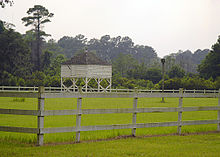 South Carolina rice plantation (Mansfield Plantation, Georgetown.)
South Carolina rice plantation (Mansfield Plantation, Georgetown.)
In 1694, rice arrived in South Carolina, probably originating from Madagascar.[31]
In the United States, colonial South Carolina and Georgia grew and amassed great wealth from the Slavery labor obtained from the Senegambia area of West Africa and from coastal Sierra Leone. At the port of Charleston, through which 40% of all American slave imports passed, slaves from this region of Africa brought the highest prices, in recognition of their prior knowledge of rice culture, which was put to use on the many rice plantations around Georgetown, Charleston, and Savannah. From the enslaved Africans, plantation owners learned how to dyke the marshes and periodically flood the fields. At first the rice was milled by hand with wooden paddles, then winnowed in sweetgrass baskets (the making of which was another skill brought by slaves from Africa). The invention of the rice mill increased profitability of the crop, and the addition of water power for the mills in 1787 by millwright Jonathan Lucas was another step forward. Rice culture in the southeastern U.S. became less profitable with the loss of slave labor after the American Civil War, and it finally died out just after the turn of the 20th century. Today, people can visit the only remaining rice plantation in South Carolina that still has the original winnowing barn and rice mill from the mid-19th century at the historic Mansfield Plantation in Georgetown, South Carolina. The predominant strain of rice in the Carolinas was from Africa and was known as "Carolina Gold." The cultivar has been preserved and there are current attempts to reintroduce it as a commercially grown crop.[33]
In the southern United States, rice has been grown in southern Arkansas, Louisiana, and east Texas since the mid-19th century. Many Cajun farmers grew rice in wet marshes and low lying prairies where they could also farm crayfish when the fields were flooded.[34] In recent years rice production has risen in North America, especially in the Mississippi River Delta areas in the states of Arkansas and Mississippi.
Rice cultivation began in California during the California Gold Rush, when an estimated 40,000 Chinese laborers immigrated to the state and grew small amounts of the grain for their own consumption. However, commercial production began only in 1912 in the town of Richvale in Butte County.[35] By 2006, California produced the second largest rice crop in the United States,[36] after Arkansas, with production concentrated in six counties north of Sacramento.[37] Unlike the Mississippi Delta region, California's production is dominated by short- and medium-grain japonica varieties, including cultivars developed for the local climate such as Calrose, which makes up as much as 85% of the state's crop.[38]
References to wild rice in the Americas are to the unrelated Zizania palustris
More than 100 varieties of rice are commercially produced primarily in six states (Arkansas, Texas, Louisiana, Mississippi, Missouri, and California) in the U.S.[39] According to estimates for the 2006 crop year, rice production in the U.S. is valued at $1.88 billion, approximately half of which is expected to be exported. The U.S. provides about 12% of world rice trade.[39] The majority of domestic utilization of U.S. rice is direct food use (58%), while 16% is used in each of processed foods and beer. The remaining 10% is found in pet food.[39]
Australia
Rice was one of the earliest crops planted in Australia by British settlers, who had experience with rice plantations in the Americas and the subcontinent.
Although attempts to grow rice in the well-watered north of Australia have been made for many years, they have consistently failed because of inherent iron and manganese toxicities in the soils and destruction by pests.
In the 1920s it was seen as a possible irrigation crop on soils within the Murray-Darling Basin that were too heavy for the cultivation of fruit and too infertile for wheat.[40]
Because irrigation water, despite the extremely low runoff of temperate Australia, was (and remains) very cheap, the growing of rice was taken up by agricultural groups over the following decades. Californian varieties of rice were found suitable for the climate in the Riverina, and the first mill opened at Leeton in 1951.
Even before this Australia's rice production greatly exceeded local needs,[40] and rice exports to Japan have become a major source of foreign currency. Above-average rainfall from the 1950s to the middle 1990s[41] encouraged the expansion of the Riverina rice industry, but its prodigious water use in a practically waterless region began to attract the attention of environmental scientists. These became severely concerned with declining flow in the Snowy River and the lower Murray River.
Although rice growing in Australia is highly profitable due to the cheapness of land, several recent years of severe drought have led many to call for its elimination because of its effects on extremely fragile aquatic ecosystems. The Australian rice industry is somewhat opportunistic, with the area planted varying significantly from season to season depending on water allocations in the Murray and Murrumbidgee irrigation regions.
Production and commerce
Production of rice by country — 2007
(million metric ton)[42] People's Republic of China
People's Republic of China197  India
India131  Indonesia
Indonesia64  Bangladesh
Bangladesh45  Vietnam
Vietnam39  Thailand
Thailand31  Myanmar
Myanmar31  Philippines
Philippines16  Brazil
Brazil13  Japan
Japan11  Pakistan
Pakistan10  United States
United States10 Source:
Food and Agriculture OrganizationProduction
World production of rice[43][dead link] has risen steadily from about 200 million tonnes of paddy rice in 1960 to over 678 million tonnes in 2009.
Harvesting, drying and milling
Unmilled rice, known as paddy (Indonesia and Malaysia: padi; Philippines, palay), is usually harvested when the grains have a moisture content of around 25 percent. In most Asian countries, where rice is almost entirely the product of smallholder agriculture, harvesting is carried out manually, although there is a growing interest in mechanical harvesting. Harvesting can be carried out by the farmers themselves, but is also frequently done by seasonal labour groups. Harvesting is followed by threshing, either immediately or within a day or two. Again, much threshing is still carried out by hand but there is an increasing use of mechanical threshers. Subsequently, paddy needs to be dried to bring down the moisture content to no more than 20 percent for milling. A familiar sight in several Asian countries is paddy laid out to dry along roads. However, in most countries the bulk of drying of marketed paddy takes place in mills, with village-level drying being used for paddy to be consumed by farm families. Mills either sun dry or use mechanical driers or both. Drying has to be carried out quickly to avoid the formation of moulds. Mills range from simple hullers, with a throughput of a couple of tons a day, that simply remove the outer husk, to enormous operations that can process 4,000 tons a day and produce highly polished rice. A good mill can achieve a paddy-to-rice conversion rate of up to 72 percent but smaller, inefficient mills often struggle to achieve 60 percent. These smaller mills often do not buy paddy and sell rice but only service farmers who want to mill their paddy for their own consumption.
Distribution
Because of the importance of rice to human nutrition and food security in Asia, the domestic rice markets tend to be subject to considerable state involvement. While the private sector plays a leading role in most countries, agencies such as BULOG in Indonesia, the NFA in the Philippines, VINAFOOD in Vietnam and the Food Corporation of India are all heavily involved in purchasing of paddy from farmers or rice from mills and in distributing rice to poorer people. BULOG and NFA monopolise rice imports into their countries while VINAFOOD controls all exports from Vietnam.[44]
Trade
World trade figures are very different to those for production, as only about 5–6% of rice produced is traded internationally. The largest three exporting countries are Thailand, Vietnam, and the United States.[citation needed] Major importers usually include Bangladesh, the Philippines, Brazil and some African and Persian Gulf countries. Although China and India are the two largest producers of rice in the world, both countries consume the majority of the rice produced domestically, leaving little to be traded internationally.
Price
In late 2007 to May 2008, the price of grains rose greatly due to droughts in major producing countries (particularly Australia), increased use of grains for animal feed and US subsidies for bio-fuel production. Although there was no shortage of rice on world markets this general upward trend in grain prices led to panic buying by consumers, government rice export bans (in particular, by Vietnam and India) and inflated import orders by the Philippines marketing board, the National Food Authority. This caused significant rises in rice prices. In late April 2008, prices hit 24 US cents a pound, twice the price of seven months earlier.[45]
On April 30, 2008, Thailand announced plans for the creation of the Organisation of Rice Exporting Countries (OREC) with the intention that this should develop into a price-fixing cartel for rice.[46][47] However, little progress had been made by mid-2011 to achieve this.
Worldwide consumption
Consumption of rice by country—2003/2004
(million metric ton)[48] China
China135.  India
India85.25  Indonesia
Indonesia36.95  Bangladesh
Bangladesh26.4  Vietnam
Vietnam17.7  Thailand
Thailand10.2  Myanmar
Myanmar10.2  Philippines
Philippines9.7  Japan
Japan8.7  Brazil
Brazil8.1  South Korea
South Korea5.0  United States
United States3.9  Egypt
Egypt3.3  Iran
Iran3.1  North Korea
North Korea1.6  Taiwan
Taiwan1.2  South Africa
South Africa0.7 Source:
United States Department of AgricultureBetween 1961 and 2002, per capita consumption of rice increased by 40%.
Rice is the most important crop in Asia. In Cambodia, for example, 90% of the total agricultural area is used for rice production.[49]
U.S. rice consumption has risen sharply over the past 25 years, fueled in part by commercial applications such as beer production.[50] Almost one in five adult Americans now report eating at least half a serving of white or brown rice per day.[51]
Environmental impacts
In many countries where rice is the main cereal crop, rice cultivation is responsible for most of the methane emissions.[52] Rice requires slightly more water to produce than other grains.[53]
If sea levels rise, rice will become more inclined to remain flooded for longer periods of time. The longer it stays in water, it cuts the soil off from atmospheric oxygen and causes fermentation of organic matter in the soil. During the wet season, rice cannot hold the carbon in anaerobic conditions. The microbes in the soil convert the carbon into methane which is then released through the respiration of the rice plant or through diffusion of water. Current contributions of methane from agriculture is ~15% of anthropogenic greenhouse gases, as estimated by the IPCC. A further rise in sea level of 10–85 centimeters would then stimulate the release of more methane into the air by rice plants. Methane is twenty times more potent a greenhouse gas than carbon dioxide.[54]
A 2010 study found that, as a result of rising temperatures and decreasing solar radiation during the later years of the 20th century, the rice yield growth rate has decreased in many parts of Asia, compared to what would have been observed had the temperature and solar radiation trends not occurred.[55][56] The yield growth rate had fallen 10–20% at some locations. The study was based on records from 227 farms in Thailand, Vietnam, Nepal, India, China, Bangladesh, and Pakistan. The mechanism of this falling yield was not clear but might involve increased respiration during warm nights, so expending energy without being able to photosynthesise.
Pests and diseases
Main article: List of rice diseasesRice pests are any organisms or microbes with the potential to reduce the yield or value of the rice crop (or of rice seeds).[57] Rice pests include weeds, pathogens, insects, nematode, rodents, and birds. A variety of factors can contribute to pest outbreaks, including the overuse of pesticides, improper irrigation and high rates of nitrogen fertilizer application.[58] Weather conditions also contribute to pest outbreaks. For example, rice gall midge and army worm outbreaks tend to follow periods of high rainfall early in the wet season, while thrips outbreaks are associated with drought.[59]
Several nematode species infect rice crops, causing diseases such as Ufra (Ditylenchus dipsaci), White tip disease (Aphelenchoide bessei) and root knot disease (Meloidogyne graminicola). Some nematode species such as Pratylenchus spp. are most dangerous in upland rice of all parts of the world. Rice root nematode (Hischmanniella Spp.) is a migratory endoparasite which on higher inoculum level will lead to complete destruction of a rice crop. Beyond being obligate parasites, they also decrease the vigour of plants and increase the plants' susceptibility to other pests and diseases.
Crop protection scientists are trying to develop rice pest management techniques which are sustainable. In other words, to manage crop pests in such a manner that future crop production is not threatened.[60] At present, rice pest management includes cultural techniques, pest-resistant rice varieties, and pesticides (which include insecticide). Increasingly, there is evidence that farmers' pesticide applications are often unnecessary, and even facilitate pest outbreaks.[61][62][63][64][65][66] By reducing the populations of natural enemies of rice pests,[67] misuse of insecticides can actually lead to pest outbreaks (Cohen et al. 1994). The International Rice Research Institute (IRRI) demonstrated in 1993 that a 87.5% reduction in pesticide use can lead to an overall drop in pest numbers.[68] IRRI also conducted two campaigns in 1994 and 2003, respectively, which discouraged insecticide misuse and smarter pest management in Vietnam.[69][70]
Botanicals, so-called "natural pesticides", are used by some farmers in an attempt to control rice pests. Botanicals include extracts of leaves, or a mulch of the leaves themselves. Some upland rice farmers in Cambodia spread chopped leaves of the bitter bush (Chromolaena odorata) over the surface of fields after planting. This practice probably helps the soil retain moisture and thereby facilitates seed germination. Farmers also claim the leaves are a natural fertilizer and helps suppress weed and insect infestations.[71]
Among rice cultivars there are differences in the responses to, and recovery from, pest damage.[72] Therefore, particular cultivars are recommended for areas prone to certain pest problems. The genetically based ability of a rice variety to withstand pest attacks is called resistance.[73] Three main types of plant resistance to pests are recognized as nonpreference, antibiosis, and tolerance.[74] Nonpreference (or antixenosis) describes host plants which insects prefer to avoid; antibiosis is where insect survival is reduced after the ingestion of host tissue; and tolerance is the capacity of a plant to produce high yield or retain high quality despite insect infestation.[75] Over time, the use of pest resistant rice varieties selects for pests that are able to overcome these mechanisms of resistance. When a rice variety is no longer able to resist pest infestations, resistance is said to have broken down. Rice varieties that can be widely grown for many years in the presence of pests, and retain their ability to withstand the pests are said to have durable resistance. Mutants of popular rice varieties are regularly screened by plant breeders to discover new sources of durable resistance.[76]
Major rice pests include the brown planthopper,[77] the rice gall midge,[78] the rice bug,[79] the rice leafroller,[80] rice weevils,[81] stemborer,[82] panicle rice mite, rats,[83] and the weed Echinochloa crusgali.[84]
Major rice diseases include Rice ragged stunt, Sheath Blight and tungro.[85] Rice blast, caused by the fungus Magnaporthe grisea, is the most significant disease affecting rice cultivation. There is also an ascomycete fungus, Cochliobolus miyabeanus, that causes brown spot disease in rice.[86][87]
Parasitic weeds
Rice is parasitized by the weed eudicot Striga hermonthica.[88] This parasitic weed is a devastating pest on the crop.
Cultivars
Main article: List of rice varietiesWhile most rice is bred for crop quality and productivity, there are varieties selected for characteristics such as texture, smell, and firmness. Cultivars exist that are adapted to deep flooding, and these are generally called "floating rice".[89]
There are four major categories of rice worldwide: indica, japonica, aromatic and glutinous. The different varieties of rice are not considered interchangeable, either in food preparation or agriculture, so as a result, each major variety is a completely separate market from other varieties. It is common for one variety of rice to rise in price while another one drops in price.[90]
The largest collection of rice cultivars is at the International Rice Research Institute[91] in the Philippines, with over 100,000 rice accessions[92] held in the International Rice Genebank.[93] Rice cultivars are often classified by their grain shapes and texture. For example, Thai Jasmine rice is long-grain and relatively less sticky, as long-grain rice contains less amylopectin than short-grain cultivars. Chinese restaurants often serve long-grain as plain unseasoned steamed rice though short-grain rice is common as well. Japanese mochi rice and Chinese sticky rice are short-grain. Chinese people use sticky rice which is properly known as "glutinous rice" (note: glutinous refer to the glue-like characteristic of rice; does not refer to "gluten") to make zongzi. The Japanese table rice is a sticky, short-grain rice. Japanese sake rice is another kind as well.
Indian rice cultivars include long-grained and aromatic Basmati (ਬਾਸਮਤੀ) (grown in the North), long and medium-grained Patna rice and short-grained Sona Masoori (also spelled Sona Masuri). In the state of Tamil Nadu, the most prized cultivar is ponni which is primarily grown in the delta regions of Kaveri River. Kaveri is also referred to as ponni in the South and the name reflects the geographic region where it is grown. In the Western Indian state of Maharashtra, a short grain variety called Ambemohar is very popular. This rice has a characteristic fragrance of Mango blossom.
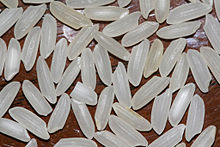 Polished Indian sona masuri rice grains
Polished Indian sona masuri rice grains
Aromatic rices have definite aromas and flavours; the most noted cultivars are Thai fragrant rice, Basmati, Patna rice, Vietnamese fragrant rice, and a hybrid cultivar from America sold under the trade name, Texmati. Both Basmati and Texmati have a mild popcorn-like aroma and flavour. In Indonesia there are also red and black cultivars.
High-yield cultivars of rice suitable for cultivation in Africa and other dry ecosystems called the new rice for Africa (NERICA) cultivars have been developed. It is hoped that their cultivation will improve food security in West Africa.
Draft genomes for the two most common rice cultivars, indica and japonica, were published in April 2002. Rice was chosen as a model organism for the biology of grasses because of its relatively small genome (~430 megabase pairs). Rice was the first crop with a complete genome sequence.[94]
On December 16, 2002, the UN General Assembly declared the year 2004 the International Year of Rice. The declaration was sponsored by more than 40 countries.
Biotechnology
High-yielding varieties
Main article: High-yielding varietyThe High Yielding Varieties are a group of crops created intentionally during the Green Revolution to increase global food production. Rice, like corn and wheat, was genetically manipulated to increase its yield. This project enabled labor markets in Asia to shift away from agriculture, and into industrial sectors. The first "Rice Car", IR8 was produced in 1966 at the International Rice Research Institute which is based in the Philippines at the University of the Philippines' Los Baños site. IR8 was created through a cross between an Indonesian variety named "Peta" and a Chinese variety named "Dee Geo Woo Gen."[95]
Scientists have identified and cloned many genes involved in the gibberellin signaling pathway, including GAI1 (Gibberellin Insensitive) and SLR1 (Slender Rice).[96] Disruption of gibberellin signaling can lead to significantly reduced stem growth leading to a dwarf phenotype. Photosynthetic investment in the stem is reduced dramatically as the shorter plants are inherently more stable mechanically. Assimilates become redirected to grain production, amplifying in particular the effect of chemical fertilizers on commercial yield. In the presence of nitrogen fertilizers, and intensive crop management, these varieties increase their yield two to three times.
Future potential
As the UN Millennium Development project seeks to spread global economic development to Africa, the "Green Revolution" is cited as the model for economic development. With the intent of replicating the successful Asian boom in agronomic productivity, groups like the Earth Institute are doing research on African agricultural systems, hoping to increase productivity. An important way this can happen is the production of "New Rices for Africa" (NERICA). These rices, selected to tolerate the low input and harsh growing conditions of African agriculture are produced by the African Rice Center, and billed as technology "from Africa, for Africa". The NERICA have appeared in The New York Times (October 10, 2007) and International Herald Tribune (October 9, 2007), trumpeted as miracle crops that will dramatically increase rice yield in Africa and enable an economic resurgence. Ongoing research in China to develop perennial rice could result in enhanced sustainability and food security.
Golden rice
Main article: Golden riceRice kernels do not contain vitamin A, so people who obtain most of their calories from rice are at risk of vitamin A deficiency. German and Swiss researchers have genetically engineered rice to produce beta-carotene, the precursor to vitamin A, in the rice kernel. The beta-carotene turns the processed (white) rice a "gold" color, hence the name "golden rice". The beta-carotene is converted to vitamin A in humans who consume the rice.[97] Although some rice strains produce beta-carotene in the hull, no non-genetically engineered strains have been found that produce beta-carotene in the kernel, despite the testing of thousands of strains. Additional efforts are being made to improve the quantity and quality of other nutrients in golden rice.[98]
Expression of human proteins
Ventria Bioscience has genetically modified rice to express lactoferrin, lysozyme, and human serum albumin which are proteins usually found in breast milk. These proteins have antiviral, antibacterial, and antifungal effects.[99]
Rice containing these added proteins can be used as a component in oral rehydration solutions which are used to treat diarrheal diseases, thereby shortening their duration and reducing recurrence. Such supplements may also help reverse anemia.[100]
See also
- Rice production
- Ambemohar
- Basmati rice
- Beaten rice
- Bhutanese red rice
- Black rice
- Brown rice syrup
- Forbidden rice
- Germinated brown rice
- Hatsuga genmai
- Inari
- Indonesian rice table
- International Rice Research Institute
- Irrigated Rice Research Consortium
- Jasmine rice
- List of rice dishes
- List of rice varieties
- Navara rice
- New Rice for Africa
- Nutritious Rice for the World
- Post-harvest losses
- Protein per unit area
- Puffed rice
- Red rice
- Rice Belt
- Rice bran oil
- Rice bread
- Rice ethanol
- Rice shortage
- Rice wine
- Risotto
- Rosematta rice
- Straw
- System of Rice Intensification
- Weedy rice
- White rice
- Wild rice
Notes
- ^ "ProdSTAT". FAOSTAT. http://faostat.fao.org/site/567/DesktopDefault.aspx. Retrieved December 26, 2006.
- ^ Yahoo! Answers
- ^ Smith, Bruce D. The Emergence of Agriculture. Scientific American Library, A Division of HPHLP, New York, 1998.
- ^ International Rice Research Institute The Rice Plant and How it Grows Retrieved January 29, 2008[dead link]
- ^ rice, Online Etymology Dictionary
- ^ rice, Oxford Dictionaries
- ^ ὄρυζα, Henry George Liddell, Robert Scott, A Greek-English Lexicon, on Perseus
- ^ Risks of Talcum Powder
- ^ Jianguo G. Wu; Chunhai Shia and Xiaoming Zhanga (2003). "Estimating the amino acid composition in milled rice by near-infrared reflectance spectroscopy". Field Crops Research. http://www.sciencedirect.com/science?_ob=ArticleURL&_udi=B6T6M-44XK5WK-3&_user=918210&_rdoc=1&_fmt=&_orig=search&_sort=d&view=c&_acct=C000047944&_version=1&_urlVersion=0&_userid=918210&md5=65f76ac6c52c83d057a73ee21f915f0e#sec7. Retrieved January 8, 2008.
- ^ The latter method of using excess water is not desirable with enriched rice, as much of the enrichment additives are flushed away when the water is discarded.
- ^ Watson, p. 15
- ^ Shoichi Ito and Yukihiro Ishikawa Tottori University, Japan. "(Marketing of Value-Added Rice Products in Japan: Germinated Grown Rice and Rice Bread.)". http://www.hatsuga.com/DOMER/english/en/GBRRB.html. Retrieved February 12, 2004.
- ^ USDA
- ^ raw, uncooked
- ^ germ, crude
- ^ white, long-grain,regular, raw, unenriched
- ^ sweet, yellow, raw
- ^ white, flesh and skin, raw
- ^ IRRI rice knowledge bank
- ^ drought tolerance in upland rice
- ^ Vaughan et al. (2008). "The evolving story of rice evolution". Plant Science 174 (4): 394–408. doi:10.1016/j.plantsci.2008.01.016.
- ^ a b c Harris, David R. (1996). The Origins and Spread of Agriculture and Pastoralism in Eurasia. Psychology Press. p. 565. ISBN 1857285387.
- ^ MacNeish R. S. and Libby J. eds. (1995) Origins of Rice Agriculture. Publications in Anthropology No. 13.
- ^ a b "World's 'oldest' rice found", Dr David Whitehouse". BBC News. October 21, 2003. http://news.bbc.co.uk/1/hi/sci/tech/3207552.stm. Retrieved April 30, 2011.
- ^ Kim, Minkoo (2008). "Multivocality, Multifaceted Voices, and Korean Archaeology". Evaluating Multiple Narratives: Beyond Nationalist, Colonialist, Imperialist Archaeologies. New York: Springer. p. 118. ISBN 978-0-387-76459-7.
- ^ http://www.sciencenewsline.com/biology/2011050313000047.html
- ^ http://www.ias.ac.in/currsci/aug252009/564.pdf
- ^ a b National Research Council (February 14, 1996). "African Rice". Lost Crops of Africa: Volume I: Grains. Lost Crops of Africa. 1. National Academies Press. ISBN 978-0-309-04990-0. http://books.nap.edu/openbook.php?record_id=2305&page=17. Retrieved July 18, 2008.
- ^ a b c Watson, p. 17-18
- ^ H.C. Darby, "The face of Europe on the eve of the great discoveries", in The New Cambridge Modern History, vol. 1, 1957:32.
- ^ a b Slavery in America: Rice and Slavery
- ^ Carney, Judith Ann (2001). Black rice: the African origins of rice cultivation in the Americas. Cambridge: Harvard University Press. ISBN 0-674-00452-3.
- ^ Carolina Gold Rice Foundation
- ^ Farm Raised Crawfish
- ^ Ching Lee (2005). "Historic Richvale — the birthplace of California rice". California Farm Bureau Federation. http://www.cfbf.com/magazine/MagazineStory.cfm?ID=17&ck=70EFDF2EC9B086079795C442636B55FB. Retrieved August 10, 2007.
- ^ "California's Rice Growing Region". California Rice Commission. http://www.calrice.org/e7b_cas_rice_growing_region.htm. Retrieved August 10, 2007.
- ^ Daniel A. Sumner; Henrich Brunke (2003). "The economic contributions of the California rice industry". California Rice Commission. http://www.calrice.org/c3a_economic_impact.htm. Retrieved August 10, 2007.
- ^ "Medium Grain Varieties". California Rice Commission. http://www.calrice.org/b6a_medium.htm. Retrieved August 10, 2007.
- ^ a b c States Department of Agriculture August 2006, Release No. 0306.06, U.S. RICE STATISTICS
- ^ a b Wadham, Sir Samuel; Wilson, R. Kent and Wood, Joyce; Land Utilization in Australia, 3rd ed. Published 1957 by Melbourne University Press; p. 246
- ^ Australian Bureau of Meteorology; Climatic Atlas of Australia: Rainfall; published 2000 by Bureau of Meteorology, Melbourne, Victoria
- ^ fao.org. "Agriculture Statistics > Grains > Rice production (2009) by country". http://faostat.fao.org. Retrieved May 6, 2010
- ^ all figures from UNCTAD 1998–2002 and the International Rice Research Institute statistics (accessed September 2005)
- ^ Shahidur Rashid, Ashok Gulari and Ralph Cummings Jnr (eds), From Parastatals to Private Trade. International Food Policy Research Institute and Johns Hopkins University Press, 2008
- ^ "Cyclone fuels rice price increase", BBC News, May 7, 2008
- ^ "Mekong nations to form rice price-fixing cartel", Radio Australia, April 30, 2008.
- ^ "PM floats idea of five-nation rice cartel", Bangkok Post, May 1, 2008.
- ^ Nationmaster.com. "Agriculture Statistics > Grains > Rice consumption (most recent) by country". http://www.nationmaster.com/graph/agr_gra_ric_con-agriculture-grains-rice-consumption. Retrieved April 24, 2008
- ^ Don Puckridge, The Burning of the Rice
- ^ United States Department of Agriculture (USDA) Economic Research Service. "Briefing Rooms: Rice". http://www.ers.usda.gov/Briefing/Rice/. Retrieved April 24, 2008
- ^ Iowa State University (July 2005). Rice Consumption in the United States: New Evidence from Food Consumption Surveys. http://publications.iowa.gov/2781/.
- ^ Methane Emission from Rice Fields – Wetland rice fields may make a major contribution to global warming by Heinz-Ulrich Neue.
- ^ report12.pdf Virtual Water Trade – Proceedings of the International Expert Meeting on Virtual Water Trade p. 108
- ^ IPCC. Climate Change 2007: Synthesis Report. United Nations Environment Programme, 2007:Ch5, 8, and 10.IPCC.ch
- ^ Welch, Jarrod R.; Vincent, J.R.; Auffhammer, M.; Doberman, A.; Moya, P.; Dawe, D. (2010). "Rice yields in tropical/subtropical Asia exhibit large but opposing sensitivities to minimum and maximum temperatures". Proc. Natl. Acad. Sci. U.S.A. 107 (33): 14562–7. doi:10.1073/pnas.1001222107. PMC 2930450. PMID 20696908. http://www.pubmedcentral.nih.gov/articlerender.fcgi?tool=pmcentrez&artid=2930450.
- ^ Black, Richard Rice yields falling under global warming BBC News Science & Environment, August 9, 2010, retrieved August 9, 2010.
- ^ Gary C. Jahn; JA Litsinger, Y Chen and A Barrion (2007). O Koul and GW Cuperus. ed. Ecologically Based Integrated Pest Management. CAB International. pp. 315–366. ISBN 9781845930646.
- ^ e.g. Jahn et al. 2005
- ^ Douangboupha et al. 2006
- ^ Jahn et al. 2001
- ^ Jahn et al. 1996
- ^ 2004a,b)
- ^ SCIDEV.net
- ^ IRRI.org
- ^ IRRI.org
- ^ Science.notary.ru
- ^ (Jahn 1992)
- ^ http://irri.org/knowledge/publications/rice-today/special-reports/science-shorts/the-pesticide-paradox
- ^ ‘Three Gains, Three Reductions’
- ^ ‘No Early Spray’
- ^ (Jahn et al. 1999)
- ^ (Jahn et al. 2004c, Khiev et al. 2000)
- ^ Definition of resistance
- ^ Painter 1951, Smith 2005)
- ^ Kogan and Ortman, 1978
- ^ (e.g. Liu et al. 2005, Sangha et al. 2008)
- ^ (Preap et al. 2006)
- ^ (Jahn and Khiev 2004)
- ^ (Jahn et al. 2004c)
- ^ (Murphy et al. 2006)
- ^ Rice weevils
- ^ IRRI Rice insect pest factsheets
- ^ (Leung et al. 2002)
- ^ (Pheng et al. 2001)
- ^ IRRI Rice Diseases factsheets
- ^ CBWinfo.com
- ^ Invasive.org
- ^ Yoshida, Satoko; Maruyama, Shinichiro; Nozaki, Hisayoshi; Shirasu, Ken (May 28, 2010). "Horizontal Gene Transfer by the Parasitic Plant Stiga hermanthica". Science 328 (5982): 1128. doi:10.1126/science.1187145. PMID 20508124.
- ^ Cgiar.org
- ^ "The U.S. Rice Export Market". USDA. Nov 2000. http://www.ers.usda.gov/briefing/Rice/SpecialArticle/USricemarket.pdf.
- ^ IRRI.org
- ^ IRRI.org
- ^ Jackson MT (September 1997). "Conservation of rice genetic resources: the role of the International Rice Genebank at IRRI". Plant Mol. Biol. 35 (1–2): 61–7. doi:10.1023/A:1005709332130. PMID 9291960. http://www.kluweronline.com/art.pdf?issn=0167-4412&volume=35&page=61.
- ^ Gillis, Justing (August 11, 2005). "Rice Genome Fully Mapped". washingtonpost.com. http://www.washingtonpost.com/wp-dyn/content/article/2005/08/10/AR2005081001054.html?referrer=email.
- ^ Rice Varieties: IRRI Knowledge Bank. Accessed August 2006
- ^ Yamaguchi, S. (2008). "Gibberellin Metabolism and its Regulation". Ann Rev Plant Biol 59: 225–251. doi:10.1146/annurev.arplant.59.032607.092804.
- ^ "Researchers Determine That Golden Rice Is an Effective Source of Vitamin A". American Society for Nutrition. 2009. http://www.goldenrice.org/PDFs/ASNonGR.pdf. Retrieved October 28, 2010.
- ^ Grand Challenges in Global Health, Press release, June 27, 2005
- ^ Nature's story
- ^ Bethell DR, Huang J (June 2004). "Recombinant human lactoferrin treatment for global health issues: iron deficiency and acute diarrhea". Biometals 17 (3): 337–42. doi:10.1023/B:BIOM.0000027714.56331.b8. PMID 15222487. http://www.kluweronline.com/art.pdf?issn=0966-0844&volume=17&page=337.
References
- Cohen, J.E.; Schoenly, K.; Heong, K.L.; Justo, H.; Arida, G.; Barrion, A.T.; Litsinger, J.A. (1994). "A Food Web Approach to Evaluating the Effect of Insecticide Spraying on Insect Pest Population Dynamics in a Philippine Irrigated Rice Ecosystem". Journal of Applied Ecology 31 (4): 747–763. doi:10.2307/2404165. JSTOR 2404165.
- Crawford, G.W.; Shen, C. (1998). "The Origins of Rice Agriculture: Recent Progress in East Asia". Antiquity 72: 858–866.
- Crawford, G.W.; Lee, G.-A. (2003). "Agricultural Origins in the Korean Peninsula". Antiquity 77 (295): 87–95.
- Douangboupha, B., K. Khamphoukeo, S. Inthavong, J. Schiller, and G. Jahn. 2006. Pests and diseases of the rice production systems of Laos. Pp. 265–281. In J.M. Schiller, M.B. Chanphengxay, B. Linquist, and S. Appa Rao, editors. Rice in Laos. Los Baños (Philippines): International Rice Research Institute. 457 p. ISBN 978-971-22-0211-7.
- Heong, KL, YH Chen, Delaware Johnson, GC Jahn, M Hossain, RS Hamilton (October 14, 2005). "Letter: Debate Over a GM Rice Trial in China". Science 310 (5746): 231–3. doi:10.1126/science.310.5746.231b.
- Huang, J., Ruifa Hu, Scott Rozelle, Carl Pray (April 29, 2005). "Insect-Resistant GM Rice in Farmers' Fields: Assessing Productivity and Health Effects in China". Science 308 (5722): 688–690. doi:10.1126/science.1108972. PMID 15860626.
- Jahn, G.C. (1992). "Rice pest control and effects on predators in Thailand". Insecticide & Acaricide Tests 17: 252–3.
- Jahn, GC and B. Khiev. 2004. Gall midge in Cambodian lowland rice. pp. 71–76. In J. Benett, JS Bentur, IC Pasula, K. Krishnaiah, [eds]. New approaches to gall midge resistance in rice. Los Baños (Philippines): International Rice Research Institute and Indian Council of Agricultural Research. 195 p.
- Jahn, G. C., S. Pheng, B. Khiev, and C. Pol. 1996. Farmers’ pest management and rice production practices in Cambodian lowland rice. Cambodia-IRRI-Australia Project (CIAP), Baseline Survey Report No. 6. CIAP Phnom Penh, Cambodia, 28 pages. Knowledgebank.irri.org
- Jahn, G. C., B. Khiev, S. Pheng, and C. Pol. 1997. Pest management in rice. In H. J. Nesbitt [ed.] "Rice Production in Cambodia." Manila (Philippines): International Rice Research Institute. 83–91.
- Jahn, G. C., S. Pheng, B. Khiev, and C. Pol. 1997. Pest management practices of lowland rice farmers in Cambodia. In K. L. Heong and M. M. Escalada [editors] "Pest Management Practices of Rice Farmers in Asia." Manila (Philippines): International Rice Research Institute. 35–52. ISBN 971-22-0102-3
- Jahn, G. C., C. Pol, B. Khiev, S. Pheng, and N. Chhorn. 1999. Farmer's pest management and rice production practices in Cambodian upland and deepwater rice. Cambodia-IRRI-Australia Project, Baseline Survey Report No. 7.Knowledgebank.irri.org
- Jahn, G.C.; Pheng, S.; Khiev, B.; Pol, C. (2000). "Ecological characterization of biotic constraints to rice in Cambodia". International Rice Research Notes (IRRN) 25 (3): 23–4.
- Jahn, G. C., S. Pheng, C. Pol, B. Khiev 2000. Characterizing biotic constraints to production of Cambodian rainfed lowland rice: limitations to statistical techniques. pp. 247–268 In T. P. Tuong, S. P. Kam, L. Wade, S. Pandey, B. A. M. Bouman, B. Hardy [eds.] "Characterizing and Understanding Rainfed Environments." Proceedings of the International Workshop on Characterizing and Understanding Rainfed Environments, December 5–9, 1999, Bali, Indonesia. Los Baños (Philippines): International Rice Research Institute (IRRI). 488 p.
- Jahn, GC, B. Khiev, C. Pol, N. Chhorn, S. Pheng, and V. Preap. 2001. Developing sustainable pest management for rice in Cambodia. pp. 243–258, In S. Suthipradit, C. Kuntha, S. Lorlowhakarn, and J. Rakngan [eds.] "Sustainable Agriculture: Possibility and Direction" Proceedings of the 2nd Asia-Pacific Conference on Sustainable Agriculture October 18–20, 1999, Phitsanulok, Thailand. Bangkok (Thailand): National Science and Technology Development Agency. 386 p.
- Jahn, GC, NQ Kamal, S Rokeya, AK Azad, NI Dulu, JB Orsini, A Barrion, and L Almazan. 2004a. Completion Report on Livelihood Improvement Through Ecology (LITE), PETRRA IPM Subproject SP 27 02. Poverty Elimination Through Rice Research Assistance (PETRRA), IRRI, Dhaka. 20 pages text plus 20 pages appendices. Petrra-irri.org
- Jahn, GC, NQ Kamal, S Rokeya, AK Azad, NI Dulu, JB Orsini, M Morshed, NMS Dhar, NA Kohinur 2004b. Evaluation Report on Livelihood Improvement Through Ecology (LITE), PETRRA IPM Subproject SP 27 02. Poverty Elimination Through Rice Research Assistance (PETRRA), IRRI, Dhaka. 42 pages plus 40 pages of annexes.Petrra-irri.org
- Jahn, G.C.; Domingo, I.; Almazan, L.P.; Pacia, J. (2004c). "Effect of rice bugs (Alydidae: Leptocorisa oratorius (Fabricius)) on rice yield, grain quality, and seed viability" (PDF). Journal of Economic Entomology 97 (6): 1923–7. doi:10.1603/0022-0493-97.6.1923. PMID 15666746. http://docserver.esa.catchword.org/deliver/cw/pdf/esa/freepdfs/00220493/v97n6s20.pdf.
- Jahn GC, Almazan LP, Pacia J (2005). "Effect of nitrogen fertilizer on the intrinsic rate of increase of the rusty plum aphid, Hysteroneura setariae (Thomas) (Homoptera: Aphididae) on rice (Oryza sativa L.)" (PDF). Environmental Entomology 34 (4): 938–943. doi:10.1603/0046-225X-34.4.938. http://docserver.esa.catchword.org/deliver/cw/pdf/esa/freepdfs/0046225x/v34n4s26.pdf.
- Jahn, GC, JA Litsinger, Y Chen and A Barrion. 2007. Integrated Pest Management of Rice: Ecological Concepts. In Ecologically Based Integrated Pest Management (eds. O. Koul and G.W. Cuperus). CAB International Pp. 315–366.
- Khiev, B.; Jahn, G.C.; Pol, C.; Chhorn N. (2000). "Effects of simulated pest damage on rice yields". IRRN 25 (3): 27–8.
- Kogan, M.; Ortman, E.F. (1978). "Antixenosis a new term proposed to defined to describe Painter's "non-preference" modality of resistance". Bull. Entomol. Soc. Am. 24: 175–6.
- Leung LKP; Peter G. Cox; Gary C. Jahn; Robert Nugent (2002). "Evaluating rodent management with Cambodian rice farmers". Cambodian Journal of Agriculture 5: 21–6.
- Liu, L., Z. Van, Q. Y. Shu, and M. Maluszynski (2004). "Officially released mutant varieties in China". Mutat. Breed. Rev 14 (1): 64.
- Ma, Jian Feng; Kazunori Tamai, Naoki Yamaji, Namiki Mitani, Saeko Konishi, Maki Katsuhara, Masaji Ishiguro, Yoshiko Murata, Masahiro Yano (2006). "A silicon transporter in rice". Nature 440 (7084): 688–691. doi:10.1038/nature04590. PMID 16572174.
- Mitani, Namiki; Jian Feng Ma, Takashi Iwashita (2005). "Identification of the silicon form in xylem sap of rice (Oryza sativa L.)". Plant Cell Physiol. 46 (2): 279–283. doi:10.1093/pcp/pci018. PMID 15695469. http://pcp.oxfordjournals.org/cgi/content/abstract/46/2/279.
- Mitani, Namiki; Jian Feng Ma (2005). "Uptake system of silicon in different plant species". J. Exp. Bot. 56 (414): 1255–61. doi:10.1093/jxb/eri121. PMID 15753109. http://jxb.oxfordjournals.org/cgi/content/abstract/56/414/1255.
- Murphy, S, J Stonehouse, J Holt, J Venn, NQ Kamal, MF Rabbi, MH Haque, G Jahn, B Barrion. 2006. Ecology and management of rice hispa (Dicladispa armigera) in Bangladesh. Pp. 162––164. In Perspectives on Pests II: Achievements of research under UK Department for International Development, Crop Protection Programme 2000–05. Natural Resources International Limited. 206 pages. CPP.uk.com
- Painter, R. H. 1951. Insect resistance in crop plants. The Macmillan Co., New York.
- Pheng, S.; Khiev, B.; Pol, C.; Jahn, G.C. (2001). "Response of two rice cultivars to the competition of Echinochloa crus-gali (L.) P. Beauv". International Rice Research Institute Notes (IRRN) 26 (2): 36–7.
- Preap V., M.P. Zalucki, G.C. Jahn (2006). "Brown planthopper outbreaks and management". Cambodian Journal of Agriculture 7 (1): 17–25.
- Preap, V, GC Jahn, K Hin, N Siheng. 2005. Fish and rice management system to enable agricultural diversification. Paper presented at the 5th Asia-Pacific Congress of Entomology, October 18–21, 2005, Jeju, Korea.
- Saltini Antonio, I semi della civiltà. Grano, riso e mais nella storia delle società umane,, prefazione di Luigi Bernabò Brea Avenue Media, Bologna 1996
- Sangha JS, Chen YH, Palchamy K, Jahn GC, Maheswaran M et al. (2008). "Categories and Inheritance of Resistance to Nilaparvata lugens (Hemiptera: Delphacidae) in Mutants of Indica Rice 'IR64'". Journal of Economic Entomology 101 (2): 575–583. doi:10.1603/0022-0493(2008)101[575:CAIORT]2.0.CO;2. ISSN 0022-0493. PMID 18459427. http://docserver.ingentaconnect.com/deliver/connect/esa/00220493/v101n2/s44.pdf?expires=1210762665&id=0000&titleid=10264&checksum=06BD55645C12C20B631B2F94209FFDFC.
- Smith, C. M. 2005. Plant resistance to arthropods: molecular and conventional approaches. Springer, Amsterdam, The Netherlands.
- Nene Y.L. (2005). "Rice Research in South Asia through Ages" (PDF). Asian Agri-History 9 (2): 85–106. http://www.agri-history.org/pdf/R-r.pdf.
- Daniel Zohary and Maria Hopf, Domestication of plants in the Old World, third edition Oxford: University Press, 2000.
- Watson, Andrew (1983). Agricultural innovation in the early Islamic world. Cambridge University Press.
- Zhao, Z. (1998). "The Middle Yangtze Region in China is the Place Where Rice was Domesticated: Phytolithic Evidence from the Diaotonghuan Cave, Northern Jiangxi". Antiquity 72: 885–897.
External links
- International Rice Research Institute
- Global Rice Science Partnership
- Rice Today magazine
- Rice at the Open Directory Project
- Calories in rice
- Interviews with Pioneers of Rice Research
- Rice Knowledge Bank
- A Brief History of Rice (p. 9 – p. 12)
- Different types of rice
- A Cuban Skirmish for Rice by Isbel Diaz Torres, Havana Times, June 16, 2010
- Rice Authority.
- National Food Authority.
- Philippine Rice Research Institute.
- Safe Storage of Cooked Rice
- Rice Research and Practice
World rice production Bangladesh · Bhutan · China · Guyana · India · Indonesia · Japan · Laos · Nepal · Pakistan · Philippines · Romania · South Korea · Thailand · Vietnam
Cereals and pseudocereals Amaranth · Amaranthus caudatus · Amaranthus cruentus · Amaranthus hypochondriacus · Barley · Buckwheat · Chia · Fonio · Job's Tears · Kañiwa · Maize (corn) · Millet · Oat · Pitseed Goosefoot · Quinoa · Rice · Rye · Sorghum · Spelt · Teff · Triticale · Wheat · Wild rice
Crop wild relativeLists of countries by agricultural output rankings Cereals Fruit Vegetables Other Cacao · Cassava · Coffee · Fish · Garlic · Milk · Sugar beet · Sugar cane · Sunflower seed · Tea · Tobacco · WineRelated Irrigation · Land useCategories:- Model organisms
- Rice
- Tropical agriculture
- Crops originating from China
- Sequenced genomes
- Greek loanwords
Wikimedia Foundation. 2010.


